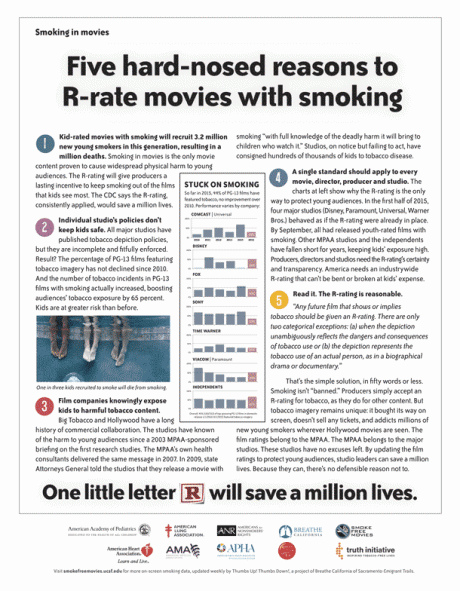September 10, 2015
On 8 September, opening day of the Toronto International Film Festival, the Ontario Tobacco Research Unit (OTRU) released a new report detailing the cost in lives and money when US movies with smoking are dumped into Canada’s youth market.
DOWNLOAD: Youth Exposure to Tobacco in Movies in Ontario, Canada: 2004-2014
Analyzing nearly 1,600 top-grossing movies released in Ontario from 2004 to 2014, researchers found that Ontario’s film rating practices make nearly all movies with tobacco accessible to adolescents.
• 90 percent of the movies were youth-rated (G/PG/14A) by the Ontario Film Review Board (OFRB).
• 86 percent of movies with smoking were youth-rated in Ontario, compared to 54% in the United States.
• Of 29,620 tobacco incidents in the movies, 85 percent were in youth-rated films, twice the number in the U.S.
• 89 percent of all tobacco impressions (an index of audience exposure) were delivered by movies youth-rated in Ontario, compared to 55 percent in the U.S.
Using US CDC models, the Ontario researchers conservatively project:
September 8, 2015
Stanton Glantz, Professor of Medicine and Director of the UC San Francisco Center for Tobacco Control Research and Education is seeking two individuals interested in conducting research projects related to tobacco control, specifically the influence of the tobacco industry on the scientific process, particularly as it relates to efforts to regulate secondhand smoke and cigarette design. Data collection will involve researching previously secret tobacco industry documents, written records, relevant laws,
conducting interviews and doing field research.
The successful candidate will either be appointed in the Specialist Series or as a Postdoctoral Fellow, depending on whether or not he or she holds a doctoral degree.
Appointees in the Specialist series will be expected to engage in specialized research, professional activities and do not have teaching responsibilities. Specialists are expected to use their professional expertise to make scientific and scholarly contributions, and may participate in University and Public Service. Screening of applicants will begin immediately and will continue as needed throughout the recruitment period. Salary and rank will be commensurate with the applicants experience and training.
September 8, 2015

Learn more at http://smokefreemovies.ucsf.edu/sfm-ads/ad-106
September 8, 2015
Brian Primack and his colleagues just published the second longitudinal study demonstrating that adolescents who use e-cigarettes are much more likely to progress to smoking cigarettes than adolescents who do not use e-cigarettes.
Their paper, “Progression to Traditional Cigarette Smoking After Electronic Cigarette Use Among US Adolescents and Young Adults,” published in JAMA Pediatrics, is especially strong because it is a national study of youth who were at low risk of smoking (called susceptibility) at the beginning of the study when they assessed e-cigarette use.
What they found was that the kids who used e-cigarettes were 8.3 times more likely to be actuall smoking cigarettes a year later.
In addition, among those kids who had not yet started smoking a year later, they were 8.5 times more likely to be susceptible to future smoking. In other words, the use of e-cigarettes moved them along to behavioral continuum towards smoking during the year.
September 8, 2015
Anna Song, Lauren Dutra, Tor Neilands, and I just published “Percentages of New and Current Smokers Among Adolescents and Young Adults: An 11-Year Longitudinal Study,” in JAMA Pediatrics, which shows that smokefree workplace laws and taxes are followed by lower youth initiation and smokefree bars are associated with lower smoking among young adult smokers.
Here is the UCSF press release summarizing the study and its implications:
Banning smoking in the workplace and increasing taxes on cigarettes have discouraged teens and young adults from taking up smoking, according to a study by researchers at UC San Francisco and UC Merced.
The study, published today (Sept. 8, 2015) in JAMA Pediatrics, used data on the smoking habits of a group of 12- to 18-year-olds living throughout the country in 1997. They were tracked for 11 years as they transitioned to young adults.
The researchers found that a 100 percent smoke-free environment reduced the odds of taking up smoking by one third and that the number of new smokers plummeted over time. These effects impacted nonsmokers by protecting them from the toxins of secondhand smoke.
